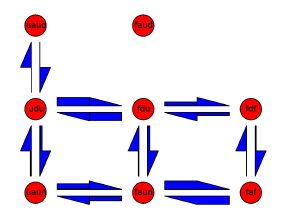Coupled folding and binding of homodimers
Collaborator: Dániel Györffy (PhD student)
Intrinsically disordered proteins are often involved in regulatory and signal transduction processes, and exert their function by binding to other proteins. This binding typically results in a disorder-to-order transition whereby the protein folds. In many cases, this process can be described as a disordered chain getting ordered on an ordered template. However, two disordered chains may also bind each other, forming an ordered homodimer. The mechanism of such ordering is an intriguing problem

We use simplified protein models, including hydrophobic-polar lattice models, to elucidate the mechanisms of coupled binding and folding in homodimeric proteins. We describe the kinetics of the system by Markov state models (see figure above), determining reaction rates under various conditions.